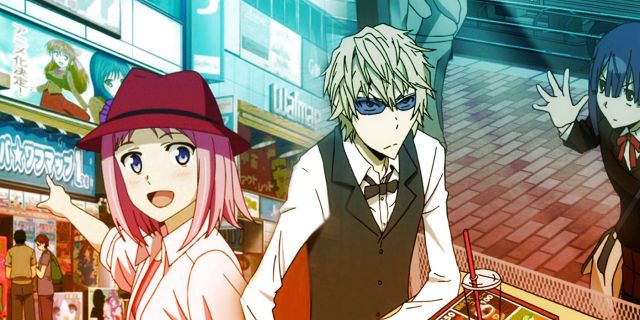It should come as no surprise that Tokyo frequently serves as the backdrop for fictitious novels given that it is the capital of Japan, the largest metropolis in terms of population, and still the most populous city in the world (with over 37 million residents). Akihabara and Ikebukuro are two of the many smaller districts and communities that make up this large city, and they are particularly well-known among aficionados of anime and manga.
Despite changes over time, Akihabara and Ikebukuro, which are around 30 minutes apart by metro, have remained popular locations in anime for a variety of pragmatic and cultural reasons. With real-world locations appearing in both classic and contemporary titles, from Di Gi Charat, Oreimo and Durarara!! to Steins;Gate, Love Live! School Idol Project and Akiba Maid War, among many others, non-Japanese viewers may wonder what exactly makes these specific neighborhoods so prevalent.
Akihabara Was Once Japan’s Hub for All Things Otaku
The downtown Tokyo neighborhood of Akihabara, sometimes known as Akiba, is a popular choice for anime set in Tokyo because to its abundance of electronic businesses and otaku-friendly culture. In reality, Akihabara earned the moniker “Electric Town” in the years right after World War II as a result of its emergence as a significant shopping destination for what were considered to be cutting-edge, ultra-modern, even futuristic household electrical equipment. However, Akihabara started to be perceived as a more specialized shopping area in the 1980s and early 1990s, when home computers started to gain popularity, mostly among business professionals and “hardcore” hobbyists. This is especially true once stores started marketing to both computer enthusiasts and the nearby video game, manga, and anime customer base that was growing at the time.
Sadly, Akihabara is no longer seen as the buzzing center of the otaku lifestyle. While plenty of electronic and anime/manga-related stores remain, gaming arcades have been closing at a comparatively rapid pace over the past several years, their demise likely hastened by the effects of COVID-19. Japanese maid cafés, the very first of which was established in Akihabara in 2001, tend to run into financial woes and close quickly. With the rise of online consumption and communication, Akihabara’s streets are no longer as bustling, and specialist otaku shops have been closing their physical storefronts, even as the popularity of e-sports increases. This is perhaps why anime such as Akiba Maid War and Steins;Gate tend to paint Akihabara with a certain sense of nostalgia, looking back to the past rather than toward the future.
For Many Fans, Ikebukuro Is Now the Mecca of Anime and Manga
Ikebukuro might be thought of as the more premium, trendier equivalent of Akihabara for younger, fresher-faced anime fans if Akihabara’s otaku glory days are fading. Because of the abundance of fashion stores and large shopping centers, the area has long been a favorite among teenagers and young adults in general. Although it may not have the same historical significance as Akihabara, Ikebukuro is also renowned as a hub of otaku culture, particularly for women. Animate, by far Japan’s largest retailer of anime, manga, and video games, has its main shop in Ikebukuro, which only just opened its doors following a significant refurbishment. Butler cafés and female-targeted dojinshi boutiques are also in abundance there.
It’s therefore no surprise that numerous anime and manga are either set in Ikebukuro or at least heavily reference it, especially when it comes to both otaku and more mainstream youth culture. The most obvious examples are the extremely popular Durarara!! and the somewhat lesser-known Ikebukuro West Gate Park — interestingly, both urban mystery stories centered around teenage and young adult street gangs, harkening back to real-life Ikebukuro’s rougher days but belying its now far more orderly atmosphere. However, Ikebukuro also makes appearances in the likes of Tokyo Ghoul, Lucky Star, Mawaru Penguindrum and even the classic Digimon Adventure.
Akihabara and Ikebukuro Both Have Immediately Recognizable Landmarks
Last but not least, considering the abundance of famous landmarks in these areas, it makes sense for anime set in or featuring Tokyo to include references to places like Akihabara and Ikebukuro. Both places feature sizable railway stations; in fact, Ikebukuro Station is among the busiest not only in Japan but also the entire world. As a result, millions of commuters travel through each day and get to know the neighborhood well. This makes it simple to get reference pictures when designing specific scenes set in these districts, and such landmarks can also help to rapidly orient viewers to specific anime places without the need for any spoken dialogue.
Aside from the stations themselves, famous landmarks such as Akihabara’s Akiba Shrine and Radio Kaikan appear in shows like Steins;Gate, as do some well-known Akihabara streets and shopping centers featured in Oreimo. Likewise, Ikebukuro’s iconic Sunshine Street gets plenty of screen time in Durarara, and a couple of real-life cafés can be spotted in Tokyo Ghoul, to name just a few examples. Although Tokyo as a whole is understandably a popular choice for real-life Japan settings in anime, Akihabara and Ikebukuro therefore remain two of the most popular of the city’s neighborhoods to depict, even as their physical and cultural landscapes have shifted over the years.















Leave a Reply